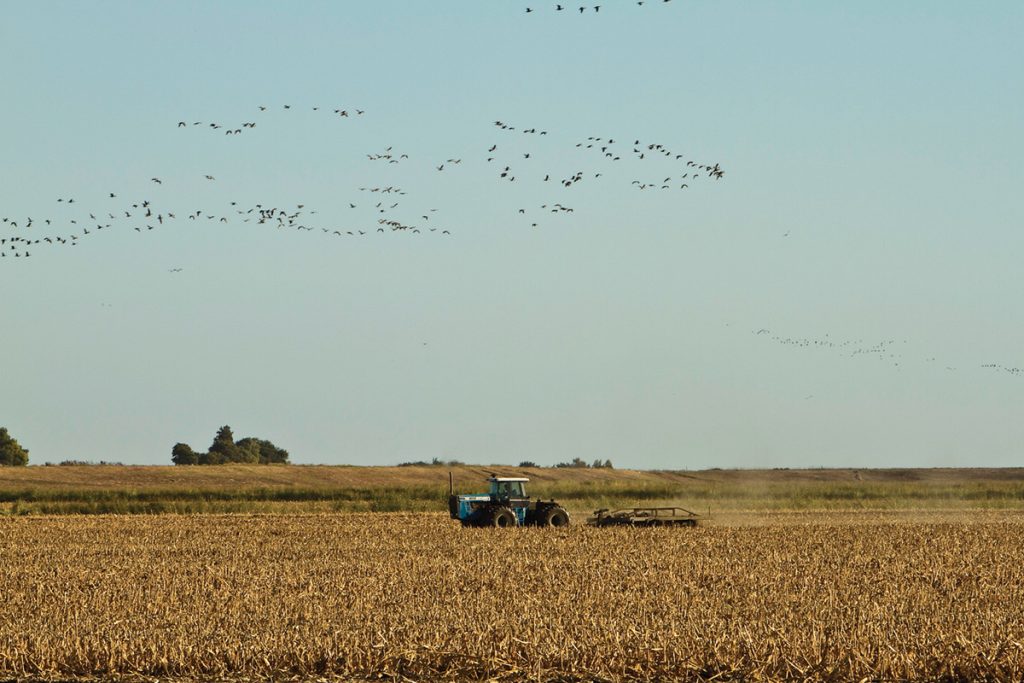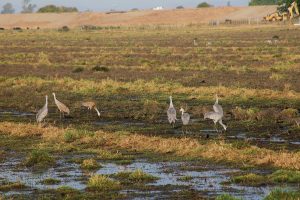
A tractor works in a subsided corn field on Staten Island in the Sacramento-San Joaquin Delta. Photo courtesy The Nature Conservancy in California.
Hundreds of thousands of people in the Bay Area get their water from the Sacramento-San Joaquin Delta, but this vital source is imperiled. Islands in the heart of the Delta have lost so much soil — literally tons — that they have sunk far below sea level, weakening the levees that protect them. Levee breaks would flood the islands, pulling in brine from the San Francisco Bay and rendering the water too salty to drink. Now, a new state program aims to reverse subsidence in the Delta and so help secure its water supply.
“That’s really exciting — they need to do something,” said Cindy Kao, who manages imported water for the Santa Clara Valley Water District. “Water from the Delta is really important to the Bay Area, we’re very dependent on it.” This water begins as snowmelt in the Sierra Nevada and then rushes down mountain streams and into mighty rivers that run hundreds of miles to their confluence in the Delta, along the border of Contra Costa and Solano counties. Kao’s agency, which serves nearly two million people, imports about 40 percent of its water from the Delta. In addition, half a million people in Contra Costa County use Delta water. The Delta also provides water to Central Valley farmers as well as 27 million people in Central Valley and Southern California communities.
The Delta was a vast wetland — 1,000 square miles of tidal and freshwater marsh — until European settlers drained it for farming. This conversion to agriculture created about one hundred islands surrounded by 2,250 miles of levees, and was complete by the 1930s. Land in a big chunk of the central Delta has been sinking ever since. While soil on the edges of the Delta is largely minerals from weathered rocks, soil on the interior islands is peat from decaying wetland plants. When peat soil is drained and exposed to air, microbes break down this bulky organic matter, combining it with oxygen to form carbon dioxide. This peat loss causes two problems: carbon escapes into the atmosphere, and soil in the central Delta shrinks.
“It’s losing up to an inch and a half a year,” said Campbell Ingram, who directs the Sacramento-San Joaquin Delta Conservancy, a state agency dedicated to environmental and economic protection in the Delta. “There’s a big hole in the middle of the Delta — 200,000 acres — that’s up to 20 to 30 feet deep.” And this, Ingram continued, causes another problem: “The big hole is basically a bathtub that’s waiting to be filled.”
Levee breaks are all it would take to fill this enormous hole in the ground with salty water from the San Francisco Bay, and a moderate earthquake is all it would take to break levees in the central Delta. This is because they’re doing a job they were never meant to do. “We call them levees but they’re actually dams,” Ingram explained. “They’re holding water back 365 days a year.” When the levees were built, the water pushing against them from the outside was counterbalanced by land supporting them from inside. As the land has subsided, however, that inside support has vanished.
The Delta Conservancy has launched a new initiative aimed at fixing all these problems — carbon emissions, soil subsidence, and water security — at the same time. Called the Delta Carbon Program, the initiative entails a two-pronged solution. First, subsided islands are flooded, protecting them from the air and so arresting further soil and carbon loss. Then the newly inundated islands are re-vegetated with water-loving plants that rebuild peat, reversing subsidence and so reducing the risk of levee failure.
This is not a quick fix; peat grows at roughly the same rate it subsides, up to two inches per year. That said, if the program takes off, it will boost water security slowly but surely. “In 40 years we could bring the risk to zero,” Ingram said. This may seem like a long time, he adds, but it also took decades for the Delta islands to get so astonishingly far below sea level. Moreover, our current do-nothing approach means that “every year we’re going the wrong direction.”
Rebuilding peat also has the benefit of sequestering carbon, opening the way to pay for the Delta Conservancy’s solution to the long-standing problem of subsidence and its threat to water security in the Delta. The California Department of Water Resources recently restored 1,700 acres of tidal marsh on Sherman and Twitchell islands in the Delta, and this is now the first wetland in the world approved to sell carbon credits that others can buy to offset their greenhouse gas emissions.
Given that most of the Delta is farmed, large-scale wetland restoration on all that deeply subsided land is unlikely.

Sandhill cranes forage for food in irrigated pastures of the Delta. Photo courtesy The Nature Conservancy in California.
But there is also an agricultural option. The Nature Conservancy is planting rice, which grows in flooded fields, to address subsidence on Staten Island. Not to be confused with the island of the same name in New York City, the Delta’s Staten Island is a showcase of wildlife-friendly farming: most of its 9,200 acres produce corn and other crops that provide income to farmers as well as food to birds migrating down the Pacific Flyway. Notably, about 5,000 sandhill cranes winter on Staten Island, feasting on grains left over from harvest. While wonderful for birds, current crops require the dry soil that leads to subsidence. Growing corn, for example, entails draining a root zone that is four feet deep. “The carbon just blows away,” Ingram said. “It blasts off into the atmosphere.”
The Nature Conservancy is converting Staten Island’s corn to rice. Besides addressing subsidence, rice will continue to provide income to farmers and residual grain to birds. “The goal is to make the Delta sustainable,” said the nonprofit organization’s Dawit Zeleke, who manages Staten Island. Ultimately, this will mean getting a good price for the carbon credits generated from rebuilding peat soil.
“The carbon market is very important,” Zeleke said. “If we want landowners to participate, there need to be incentives for family farmers who are trying to survive.”
Robin Meadows covers water for the Monitor.

